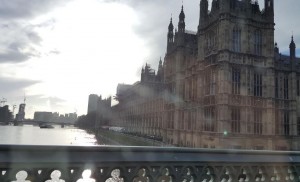Who: The Crown
What: The Coronation Spoon and Ampulla
Where: Tower of London
When: Tower of London construction started in the late 11th century, the Spoon was created in the late 12th century, the Ampulla was added in 1661
Why: Showcases the artifacts of the British Empire, from England and from its colonies
I illegally snapped this picture of the Spoon & Ampulla at the Tower of London. Marvel at it.
Pre-trip: Some would say the British are the greatest, most gloried group of thieves in human history. They bent and manipulated their subjects. Across their empire, they nabbed whatever riches they wished to keep. And they seem to hold the relics of the past close to their chests, even to this day. They represent the last vestiges of their once sprawling empire. They also highlight the might and promise that the monarchy holds, even though their only source of legitimacy in the present day is that the common people allow their existence. I was interested to see how the British would explain their conquests and imperialism to outsiders. Furthermore, I was curious to see what they felt about it themselves.
Post-trip: The Tower of London (as well as other structures, such as the British Museum) displayed the things the British have taken over the centuries from around the globe. This was not astounding. But I suppose what was astounding was how they justified the centuries of oppression and subjugation they carried out. They acknowledged how their attitudes towards “lesser” races changed, as they saw that they were advanced in their own right. They also seemed to acknowledge that not everything the Crown carried out was sacrosanct or justified. They are still proud of their history, however. And they still uphold traditions. The first picture shows the Coronation Spoon and Ampulla. The Ampulla, which contains holy oil, was used for the coronation of Charles II in 1661. As for the Spoon, it is believed to have been used in the coronation of King John in 1199. These practices have survived for centuries through the rise and fall of the British empire and monarchy, amongst other institutions and practices.
Never in the trip did I feel that the British offered an apology for the sins of the past. But they acknowledged them, and afterwards, chose not to dwell on them for too long and move on.
And I guess after all this time, that is enough, and we should all try our best to do the same.
Moments after this was taken, he threw down his rifle and started breakdancing.
Citation:
- “Ampulla.” Royal Exhibitions. 2010. Web. 23 Jan. 2016. <http://royalexhibitions.co.uk/crown-jewels-2/ampula/>.









